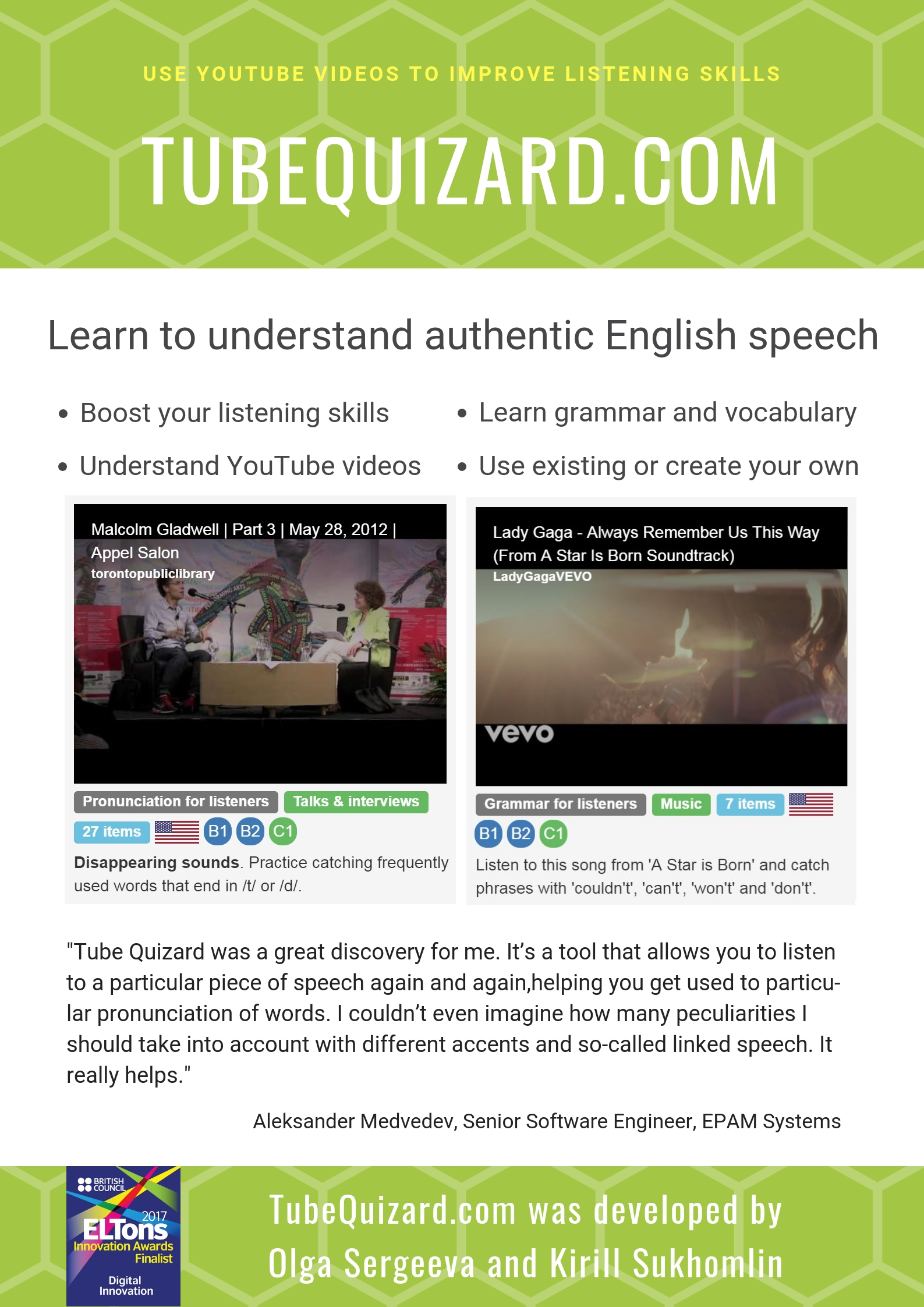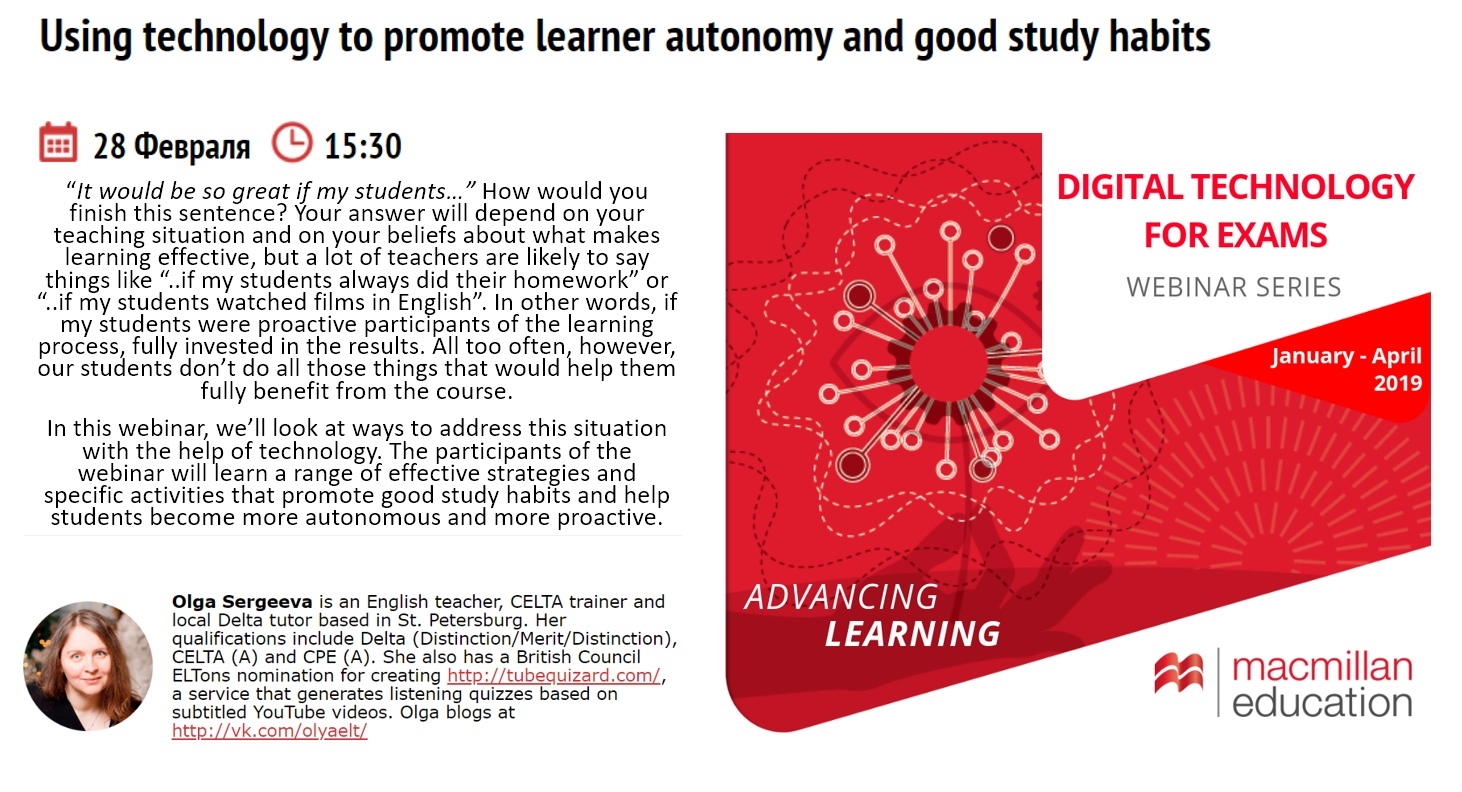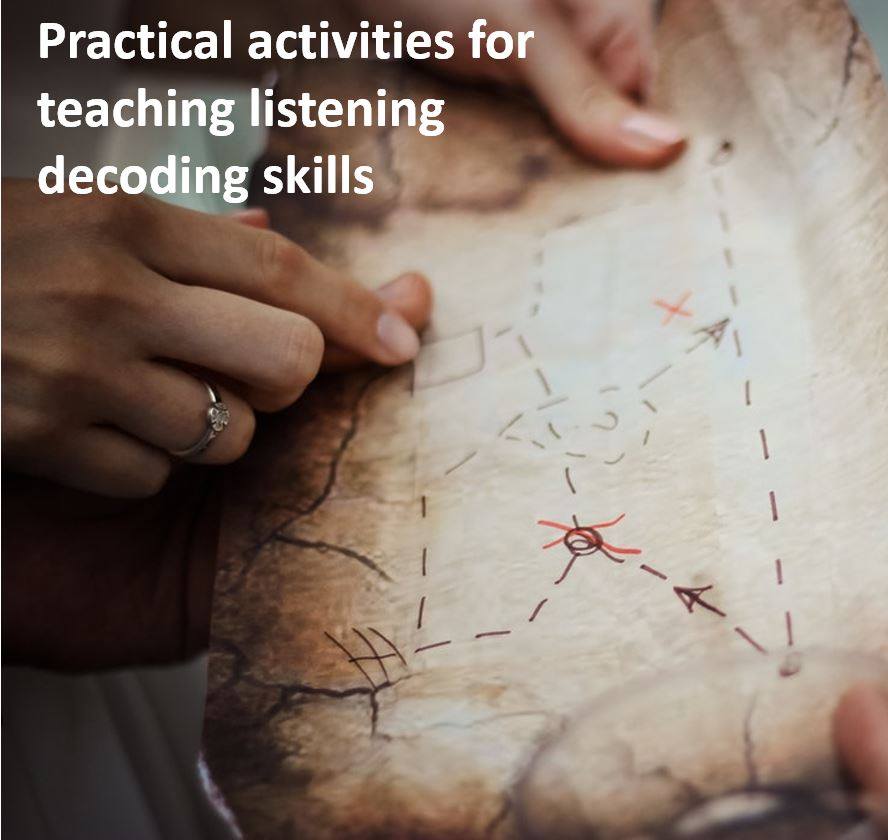If you’re participating in the IATEFL conference, come join me for a talk about TubeQuizard tomorrow afternoon? ![]()

Imagine you’re going to run a 6-participant course that you’ve taught F2F, but this time, you’re running it via Skype or Zoom. What questions / concerns / worries would you have?
This is the question that I’m going to ask my participants tomorrow in my workshop at #BESIG2019, and my goal for the workshop is to address those concerns. If you’re at the conference and are up for an early morning workshop, do come by!
If not, I’m planning to run an online training on that in early 2020 – watch this space.

Hi all,
I’ve written a quick 3-page guide to using YouTube and TubeQuizard to help learners understand real-life pronunciation in videos.




Hi everyone,
Earlier this year I gave a webinar for Macmillan Russia on using technology to promote good study habits. This was part of their Digital Technology for Exams webinar series.
I really enjoyed doing this webinar, and I’m very happy that they allowed me to share the recording.
P.S. Hat tip to Lizzie Pinard, whose IATEFL 2015 talk on learner autonomy first introduced me to some of the key ideas and sources on developing learner autonomy. After attending that talk, I shared Lizzie’s ideas with my colleagues at EPAM systems and we started experimenting on encouraging learner autonomy in a systematic way. This webinar sums some of that experience.

Back in January, I came across a post by Shaun Sweeney, in which he was inviting all fellow teachers to a new Facebook group he’d created, called TD Lab Staffroom.
The group is meant for English teachers who’d like to use authentic listening but don’t want to spend ages trying to find a recording suitable for their class. The idea is that you post a topic and fellow English teachers record very short monologues about these topics. Alternatively, post an article or a short YouTube video and fellow teachers record their responses.
All recordings made so far are being collected in a dedicated Google drive folder, along with the transcripts. The topics so far have included ‘tell about your commute’ (with elementary learners in mind), your take on New Year resolutions (and an update on those resolutions in June), Would you delete Facebook?, your take on news and media, and more than a dozen more.
I’ve been meaning to use this material, but the chance aroze only last week. The topic was What frustrates you? (posted by Daniel Christopher), and here’s a lesson plan that I wrote based on two recordings. When I listened to the two recordings, what struck me was how similarly they were structured: both contained plenty of hedging devices to avoid sounding too negative – things like ‘I should sort of relax about this I suppose, but…‘ and ‘This is just a little thing people do, but I just think..’, so I included a focus on that in the materials.
The (editable) materials are available in this Dropbox folder (the .pdf can also be downloaded from the SlideShare below) – but this is really just an example of what could be done using the recording shared in the group, so do join if you like the idea of the group. 🙂
In the past, whenever I did a workshop on decoding authentic recordings with learners, I’d invariably hear this from someone in the room: ‘But surely this is only for advanced learners??’
In my experience, you can certainly do decoding with Pre-Intermediate learners and higher, so I thought I’d record a snippet with my new group, which is B1. We’re doing listening decoding for the first time with this group in this lesson.
Before this part of the lesson, we watched four 30-second authentic videos for gist (these were videos showing small talk, and the task was to identify the topic discussed). The learners are now working with a gapped transcript, transcribing questions and responses from the video.
All in all, we spent 19 minutes doing listening decoding in that lesson: 14 minutes transcribing and then 3 minutes summarizing the features we’d heard. We then moved on to categorize the questions and have a bit of practice making small talk.
I generally try to incorporate listening decoding in this way every 2-3 lessons, and I also set TubeQuizard quizzes based on the same video for homework. And I normally start noticing progress in my learner’s ability to cope with ‘standard’ AmE accents after about 5-6 lessons that have a listening decoding element.
I thought I need to organize all EVO-related links – I’ll be adding links to this post.
The session syllabus.
A summary of three articles that heavily influenced the design of the session.
Week 1 (main focus: autonomous listening)
TED talks for autonomous listening: ten activities shared by the participants
Week 2 (main focus: traditional lesson framework and its application to authentic materials)
Authentic listening with lower levels: possible and highly recommended – experiences shared by the participants
Week 4 (main focus: listening decoding; features of connected speech)
Features of connected speech -for each feature, there’s a short description, a video and a TubeQuizard quiz that gives some examples of the feature in unscripted speech
Using Aegisub to work on listening decoding skills: a video tutorial
Week 5 (main focus: practical activities for teaching listening decoding skills)
Webinar recording – in this live session we looked at a range of listening decoding activities and software tools that allow the teacher to create such activities ‘on the fly’, and discussed how to incorporate this work into a traditional listening lesson and into the syllabus.
An annotated list of activities, lesson snippets and resources targeting listening decoding
As a follow-up to yesterday’s post (the recording of a webinar on Practical activities for teaching listening decoding skills, which was part of last year’s Electronic Village Online session on teaching listening), here are some links to activities that I collected for the session participants. These were meant as highly practical resources that could help the session participants to try out listening decoding in class. There are three sections:

SECTION A: activities that could be adapted to a wide range of listening texts
1. Fast speech frustrations by Olya Sergeeva (ET professional issue 112, September 2017)
Olya Sergeeva describes the lesson procedure that she uses in her Authentic listening courses with learners at B1 level and higher. The procedure could be used with any subtitled video stored locally on your computer, a TED talk or a subtitled YouTube video.
If you’re interested in this approach, you can also see a recording of a full lesson and sample materials in sections B and C.
2. Helping students become more effective listeners by Annie McDonald (the audio files to try out the activities are here).
Annie McDonald describes six activities that require little preparation and can be used with coursebook or authentic texts (files Decoding activities.pdf and the audio files). Activities iii.2 and iii.3 can be used with audio concordancing software (e.g. TubeQuizard or Aegisub).
3. PlayPhrase.me and Listening Discrimination by Anthony Schmidt
Anthony Schmidt describes a grammar listening discrimination activity that he created using playphrase.me, an audio concordancing service that uses snippets from TV shows. The blog post includes a PowerPoint with listening files downloaded from playphrase.me and a worksheet that can be tried out in class. Anthony’s PowerPoint activity is for B2 levels, but the activity can be adapted to all levels.
4. Catch the sound by Michael Grinberg
Michael Grinberg describes a listening activity that could be used with any audio or video, provided that you have a transcript. There’s no preparation required, but you’ll need software that allows to isolate and play short extracts from the video (such as Aegisub).
If you’re interested in Michael’s approach and want find out more about the research behind this activity, please feel free to get in touch with him here.
5. Teaching grammar through listening by Gianfranco Conti (especially activities 2.1, 2.3 and 2.4)
6. Micro-listening tasks you may not be using often enough in your lessons by Gianfranco Conti
Gianfranco Conti describes some micro-listening activities that he likes to use with beginner students.
7. Look through sample units in coursebooks produced by Sheila Thorn to get more ideas for listening decoding tasks (unfortunately, the audio files for these activities are not available).
Link 1: sample units for elementary, intermediate and advanced books in the Real Lives Real Listening series.
Link 2: sample units from another book produced in collaboration with Richard Cauldwell (scroll down to Writing project with Richard Cauldwell of Speech in Action).
=========================
SECTION B: videos of teachers demonstrating listening decoding work in class
1. A video lesson (30 minutes) in which Rachael Roberts demonstrates working on intrusive w, j and r.
The lesson comes from Nagivate Pre-Intermediate (B1) coursebook (Oxford University Press).
If you like the lesson and want to try it out with your learners, you’ll find the link to the materials in SECTION C.
2. A video (13 minutes) in which Mark Rooney demonstrates how listening decoding diagnostics and training could be introduced into any listening lesson through a few simple tweaks.
3. A lesson snippet (6 minutes) in which Julia Galichanina helps learners (B1+) analyze the speaker’s pronunciation in an authentic listening extract.
In this lesson extract,
(1) the teachers uses Aegisub to play one sentence from the video. The learners listen to the sentence several times and try to fill the gaps in the transcript
(2) the teacher elicits all learners’ ideas and boards them
(3) the teacher tells the learners the answers, and then replays the extract for the learners to analyze how the words in the gap were actually pronounced by the speaker;
(4) after this, the procedure is repeated with the next sentence.
4. A lesson (90 minutes) by Olya Sergeeva
This lesson was an introduction into listening decoding for this group of learners, who had never done this kind of work before. This particular group is Upper-Intermediate (B1+), but Olya has also done the same procedure (with different videos) with B1 groups.
If you want to try this out, the materials are in SECTION C and Olya’s article about this approach is in SECTION A.
=========================
SECTION C: materials (e.g. coursebook samples) that you can try out with your learners
1. A lesson (levels: strong B1 and higher) by Olya Sergeeva designed to raise the learners’ awareness of features of connected speech and the role they have in listening. The material is based on a subtitled YouTube interview and includes TubeQuizard quizzes.
2. A sample lesson from Navigate Pre-Intermediate (B1) by Rachael Roberts (free but registration required).
3. During his live session in Week 4, Richard Cauldwell spoke about and demonstrated a classroom activity ‘Jungle Listening: Survival Tip No. 10‘. Here you can download the Student’s book, Teacher’s book, and Audio for all ten units in these materials. Level: B1.
If you use Survival Tip no. 10 – or any of the other nine tips – in class, do get in touch with Richard to let him know how it went. You don’t have to be polite! If you do not like the materials, say why (it will be helpful for Richard). Also, if you like them, say why (which will also be helpfuul to Richard!)
4. A sample lesson on decoding weak forms of function words (levels: B1-B2) from Authentic Listening Resource Pack by Marck Hancock and Annie McDonald.
5. Pronunciation as a listening skill by Mark Hancock is a collection of awareness raising activities that could be used at a range of levels. Also, explore the site with fun materials created by him and Annie McDonald. Don’t miss Hay Chewed and the classic, The Word Blender.
6. TubeQuizard offers a selection of YouTube-based listening decoding activities. You can use the selection of ready-made quizzes or create quizzes based on any subtitled YouTube videos. Find a 12-minute tutorial here.
=========================
I hope you find this useful – if you think I’m missing a good resource, could you share the link?
This blog post was 18 months in the making.
Last year I did a webinar on Practical activities for teaching listening decoding skills for the Electronic Village Online session on Teaching Listening. The recording created by the webinar platform was in .exe format so I couldn’t share it, but I really enjoyed the webinar and have been meaning to create a screencast. Today I finally got round to making one, so here goes! The recording is divided into several parts because during the session I gave the participants links to some YouTube videos that I don’t own the copyright to. Would be very happy to hear your feedback if you watch it.
Best wishes,
Olya
Title: Practical activities for teaching listening decoding skills
Abstract: During the session we will:
(1) discuss how to incorporate working on listening decoding activities into your lessons and syllabus;
(2) try out a variety of listening decoding activities;
(3) watch and discuss videos of teachers demonstrating work on listening decoding skills;
(4) look at some software tools that you could use to create listening decoding activities.
Recording:
Part 1: an overview of the webinar:
Watch this video and think what levels you could use it with:
Part 2: analysis of Leo’s speech + an overview of two types of listening decoding activities
(link: http://ytcropper.com/cropped/fN5a80538fefba6)
Watch and analyze an extract from a lesson by Mark Rooney. What support does he give the learners when diagnosing their problem? How does he help them to train to distinguish between the sounds?
(link: http://ytcropper.com/cropped/do5a805cb335913)
Part 3: analysis of the extract with Mark Rooney:
Watch this extract from a lesson by Rachael Roberts, one of the authors of Navigate, and guess which feature of connected speech she’s focusing on:
(link: http://ytcropper.com/cropped/J05a805f9d6af3e)
Part 4:
Watch another extract from Rachael Roberts’s lesson and analyze what kind of support she gives (link: http://ytcropper.com/crop.php?ytURL=J0ti4cziL-M)
Part 5: the rest of the session (in this part I mention Aegisub, a handy tool that allows users to create some activity types ‘on the fly’. At the end of this post there’s an 8-minute tutorial that explains how to work with Aegisub.)
Aegisub tutorial: